BMW Z3
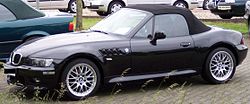 | |
| Manufacturer | BMW |
|---|---|
| Production | 1996–2002 |
| Assembly | Spartanburg, South Carolina |
| Predecessor | BMW Z1 |
| Successor | BMW Z4 |
| Class | Roadster |
| Body style(s) | 2-door convertible 2-door coupé |
| Layout | FR layout |
| Platform | BMW E36 |
| Engine(s) | 1.8 L M43B18 I4 1.9 L M44B19 I4 2.0 L M52B20 T I6 2.2 L M54B22 I6 2.8 L M52B28 I6 3.2 L S52B32 I6 2.5 L M52B25 I6 2.5 L M54B25 I6 3.0 L M54B30 I6 3.2 L S54B32 I6 |
| Transmission(s) | 4-speed automatic 5-speed manual |
| Wheelbase | 96.3 in (2446 mm) |
| Length | 158.5 in (4026 mm) |
| Width | 1996-98: 66.6 in (1692 mm) 1999-2002: 68.5 in (1740 mm) |
| Height | 1996-98: 50.7 in (1288 mm) 1999-2002 Roadster: 50.9 in (1293 mm) Coupe: 51.4 in (1306 mm) |
| Fuel capacity | 13.5 US gal (51 L/11 imp gal) |
| Related | BMW 3-Series |
The BMW Z3 was the first modern mass-market roadster produced by BMW, as well as the first new BMW model assembled in the United States. (The very first BMW assembled in the US was the E36/4, 318i that rolled off the Plant Spartanburg assembly line beginning in October 1994.) The Z3 was introduced as a 1996 model year vehicle, shortly after being featured in the James Bond movie, GoldenEye. There were a few variants of the car before its production run ended in 2002, including a coupé version for 1999. It was manufactured and assembled in Spartanburg, South Carolina. The Z3 was replaced by the BMW Z4 introduced in late 2002 at the Paris Auto Show.
Overview
The Z3 was developed from the E36 platform of the 3 Series. The resulting platform is sometimes referred to as the E36/7(roadster) or E36/8(coupé). The rear semi-trailing arm suspension from the E30 was used rather than the more sophisticated multilink suspension from the E36. At first, only the 1.9 L M44B19 straight-4 engine was offered, but its 138 hp (103 kW) was not up to buyers' expectations. Interior appointments too were not up to the standard of other BMW models, and the plastic rear window looked poor compared to the glass unit found on the much less expensive 1999 Mazda MX5.
In the North American market, the inline-4 engine was complemented by a larger straight-6 engine in 1997: the 2.8 L M52B28. This engine, similar to the BMW M52 in the 328i except with an all aluminum block and head, was especially desirable with its 189 hp (141 kW). The M Roadster (see below) appeared in 1998 with a 3.2 L S52B32 I6, just as the four was retired. In 1999, the 1.9 L 4-cylinder engine was replaced with a 2.5 L straight-6 M52TUB25, producing 170 hp (130 kW). Due to marketing, BMW wanted to differentiate the 2.8 L engine from the 2.5 L engine, so it was badged it 2.3 just like the 3-Series 323i, which also has a 2.5 L engine.
Outside of North America, the 1.9 L 4-cylinder was replaced with a 2.0 L straight-6 in 1999.
All of the engines were replaced when the car was freshened for 2001. The range consisted of the 2.2 L M54B22 (available outside of North America), 2.5 L M54B25, 3.0 L M54B30, and (for the M Roadster) 3.2 L S54B32. All three of these straight-6 engines lasted through the end of the car's run in 2002. Also updated was the car's interior appointments, though the plastic window remained.
The Z3 proved quite reliable, with problems limited to bad oxygen sensors, a flimsy plastic water pump, and failing rear shock mounts. With time the most common problems were rocking seats and water leaks on the roof. With its popular retro styling, the Z3s have held their value fairly well in the resale market.
Year to year standard equipment changes
1997 - Traction control;
1998 - Rollover bars;
1999 - Side airbags;
2000 - Revised tail styling;
2001 - Dynamic Brake Control.
M Roadster
From 1998 to 2002, the Motorsports division of BMW produced the M Roadster which included suspension upgrades and the engine from the BMW M3. The 1998, 1999 and 2000 M roadster had the 3.2L S52 motor from the E36 M3 with quad exhaust. The 2001 and 2002 models had the S54 motor from the E46 M3. There were also interior upgrades with additional gauges in the center console, lighted "M" shift knob, various chrome bits throughout the cockpit and sport seats as standard equipment. Exterior changes were larger wheels spaced further apart and more aggressive fenders than were installed on the regular Z3. Hardtops were available as an option. The BMW Z3 M was succeeded by the BMW Z4 M.
Coupé
In addition to the roadster version of the Z3, BMW also released a coupé featuring a chassis-stiffening rear hatch area, though the Shooting-brake styling this gave was controversial. The coupé was available as the Z3 Coupé from 1999 to 2001 or as the BMW Motorsport-enhanced M Coupé from 1999 to 2002.
The Z3 coupés were only available with the largest 6-cylinder engine offered in the Z3 roadster: the 2.8 L in 1999 and 2000 and the 3.0 L in 2000 for Europe and 2001 for the US. The 1999 and 2000 M models were equipped with the 3.2 L S52 motor from the E36 BMW M3, while all the 2001 and 2002 models came with the S54 motor from the E46 BMW M3.
Notable owners
- George O'Callaghan - Professional footballer
- Linus Torvalds - Software engineer and designer of the Linux kernel
- Kenny Herman - TV Producer and writer, semi-professional race car driver, entrepreneur
- General Balfour - Chief of UK defense staff
- Brett Lee - Professional cricketer (Australia)
- Ken Thompson - Creator of the UNIX system
On film and television
- James Bond, as played by Pierce Brosnan in the film GoldenEye, drove a BMW Z3. The car is described by Q as having stinger missiles mounted behind the headlights, all points radar system with display, a self destruct system and is shown to have a parachute Braking system. However, none of these gadgets are actually utilized in the film.
- In the music video for the 'N Sync song "Bye Bye Bye" there is a scene where the girl is chasing the two men while driving. Her car was a Z3 while the other two were Dodge Vipers.
- BMW Z3 is seen in Bollywood blockbuster Kaho Naa Pyaar Hai's famous song Na Tum Jaano Na Hum and in RACE (Bollywood movie).
- This car is also seen in the movie Scream 3.
- A MZ3 Roadster was showcased in Armageddon.
- Nina Oliver (Nana Osanai in the original Japanese version), a supermodel character in Case Closed: The Fourteenth Target, drives a right-hand-drive Z3 (quite recklessly). The car actually played an indirect role in the plot of the film; it was an accident caused by Nina's reckless driving that ultimately lead the murderer to his serial killings.
- In the 2001 BMW series of short films called The Hire, Season 1 Episode 3 "The Follow", Adriana Lima is driving a BMW Z3 while being followed by the Driver (played by Clive Owen).
- In the kent song Socker (Sugar) they mention a Z3 in the second verse. "Gäst ikväll är Jesus//Han har kickat heroin//Han läppjar på sitt glas//Och Ramlösa blir vin//Han berättar om sina vapen//Sin tid i San Tropez//Om att ge sig själv en chans//Om sin nya Z3//I en värld av idioter//Står han första han först i kön" (Translation: "Guest tonight is Jesus//He is high on heroin//He drinks from his glass//And Sparkling water turns to wine//He's talking about his guns//His time in San Tropez//About giving yourself a chance//About his new Z3//In a world of idiots//He stands first in line").
- In the anime Ayashi no Ceres, Tooya drove a blue BMW Z3 when he worked for Mikage International. It appears that his car's radio has an integrated telephone--it was demonstrated in one occasion, when he received a call from his boss, Mr. Mikage, by pulling on a lever, and the call was played on the car's sound system. He was back then assigned to hunt down Aya Mikage, and two pieces of equipment were issued to him: one is the Z3, the other is a .45 pistol.
Racing
The Z3 is currently used in the KONI Challenge Series.
Awards
- The BMW Z3 won the "Super Reggie" award for the best promotional marketing campaign of 1995. The campaign was co-sponsored by the United Artist unit of Credit Lyonnais and by BMW of North America. Efforts included James Bond Edition Z3's sold through the Neiman Marcus catalogue.
- The BMW Z3 2.8 made Editor's Most Wanted Vehicle for 1999 Edmunds.com
- The M Coupe/M Roadster made Car and Driver magazine's Ten Best list for 1999.
- The BMW 2000 Z3 2.8 made one of the most exotic cars list on fantasycars.com
- The BMW 2000 2.3 made "The Best Overall Value of the Year" - "Base Sport" category winner by Intellichoice
- AUTOMOBILE Magazine awarded the BMW M coupe its 1999 Design of the Year.








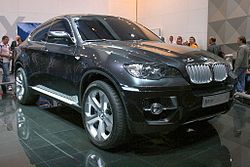
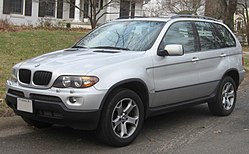
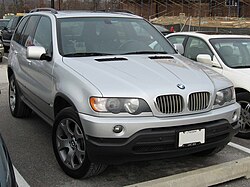
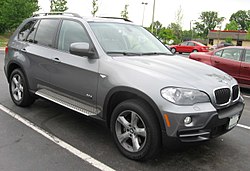
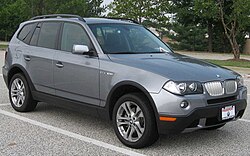
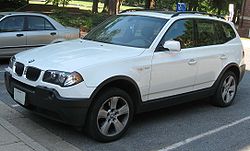





![Validate my RSS feed [Valid RSS]](valid-rss-rogers.png)














































































